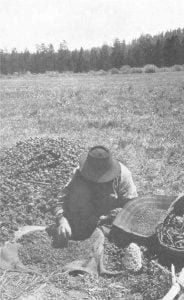In wokas pods properly roasted as well the interior tissues are in the condition of a mucilaginous paste. The seeds do not separate from this paste as readily as they do from the mucilage in pods of the spokwas grade, and therefore the Indian has invented another method of extracting them. This method is known as diachas (di-ä”-chäs”). About a peck of actual, of either the nokapk or the chiniakum grade, is placed upon a sack or upon a hard smooth area of bare ground and pounded with a small stone ská into a gluey mass. To this is added about half the quantity of dry rotten wood (mu-lo’) of a sort that is easily crumbled into dust. This is pounded and rubbed into the mass of pounded pods. Finely pulverized charcoal or ashes is often substituted for the rotten wood when the latter is not readily obtainable. After the manipulation is sufficient to take up the moisture and leave the surface of the seed dry and free about three quarts of the mixture is usually placed in a wicker screening basket (ti-a’) and the empty capsule skins screened out, the finer matter falling through into a wokas shaker. Sometimes a screen is not used. The material in such case is placed directly in a shaker, and the skins, after being brought to the top by rotating, are shoved off. The winnowing of the seeds, as in the preparation of lowak, follows, and the seeds are then made into lolensh by the process already described.
The Grades of Wokas

pounding rotten wood into the roasted pods. At the right in a shaker is a quantity of seeds already cleaned. In front of the shaker is a pounder (ska), of pumice stone, larger than the one in the woman’s hand.
Inquiry among the Indians as to the relative quality of the different kinds of wokas, irrespective of the method of cooking, but on the basis of what in the grain trade would be called grade, elicited replies showing the following order: (1) Spokwas, (2) stontablaks, (3) lowak, (4) nokapk, (5) chiniakum.
The significance of this arrangement of grades by the Indians lies in the fact that the sequence they gave represents exactly the relative degree of maturity of the seeds. In chiniakum and nokapk the seeds in the still green pods are roasted at once, usually on the day after they are gathered, and of these two grades the one called chiniakum is visibly the less fully developed. In lowak the seeds have several days longer to grow, since between the time when the pods are spread out in the drying piles and the time when they actually become dry the seeds are undoubtedly making considerable progress toward maturity. The stontablaks, lying in the center of the drying piles, and therefore remaining moist for a longer time than the pods on the surfaces of the piles, have a still further opportunity for the development of their seeds, and in spokwas the seeds are of course fully matured when they are gathered.
